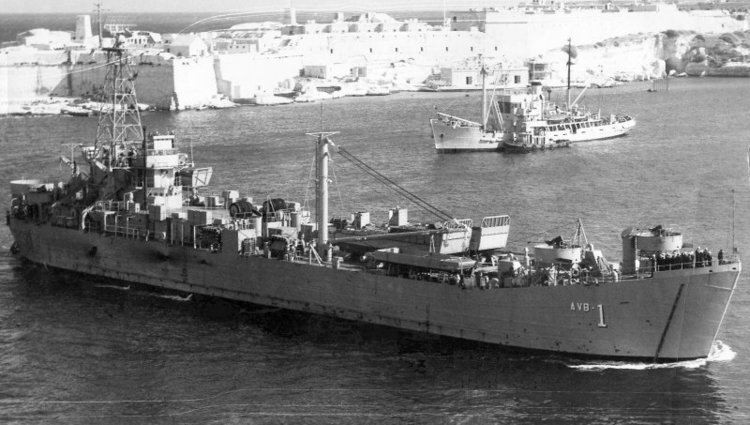Name USS LST-32 Commissioned 12 July 1943 Honors and
awards 2 battle stars (WWII) Construction started 17 February 1943 Length 100 m | Laid down 17 February 1943 Decommissioned July 1946 Recommissioned 7 March 1951 Launched 22 May 1943 Builder Dravo Corporation | |
 | ||
USS Alameda County (LST-32) was an LST-1-class tank landing ship built for the United States Navy during World War II. Named for Alameda County, California, she was the only U.S. Naval vessel to bear the name.
Contents
LST-32 was laid down on 17 February 1943 at Pittsburgh, Pennsylvania by the Dravo Corporation; launched on 22 May 1943; sponsored by Miss Dorothy M. Manko; and commissioned on 12 July 1943 with Lieutenant Gardnar P. Mulloy in command.
World War II, 1943–1946
After commissioning, LST-32 served as a training platform in Chesapeake Bay until March 1944 when she crossed the Atlantic Ocean and entered the Mediterranean Sea. On 1 April, while proceeding in a convoy from the Algerian coast to the island of Majorca, she and her consorts endured a low level attack by a formation of three German twin-engine bombers. Antiaircraft fire splashed one of them and drove off the other two. The ship operated into the summer with the task group that resupplied the Anzio beachhead. Early in August, she prepared for the invasion of southern France and, during the landings on 15 August, was among the LSTs off the Îles d'Hyères as senior radar ship. She sent two separate radar units ashore on Port Cros, one on the 15th and the second on the following day.
LST-32 spent the next 10 months carrying supplies and munitions between various ports in the Mediterranean. In January 1945, she lifted British troops to Greece to help suppress a communist attempt to take over the government. On the return trip, the vessel rescued about 100 survivors from the Greek ship SS Ionia wrecked in a storm. She later transported prisoners, elements of the French Foreign Legion, railroad cars, and other vehicles between ports in Italy, France, and North Africa before returning to the United States at New York in July 1945. The ship then moved to Norfolk to undergo repairs and alterations preparatory to her transfer to the war in the Pacific. However, the Japanese capitulation in mid-August caused both alterations and reassignment to be cancelled. Instead, LST-32 remained in the Atlantic Fleet until July 1946 when she was decommissioned and placed in reserve at Green Cove Springs, Florida.
6th Fleet, 1951–1962
Reactivated as a part of the Navy's expansion of its active fleet following the communist invasion of South Korea, the ship was recommissioned on 7 March 1951 with Lieutenant John W. Leonard in command and operated with the Atlantic Fleet Amphibious Force until reassigned to the Atlantic Fleet Naval Air Force in April 1953. By September, she was operating out of Naples, Italy, serving as an advanced base support ship with Air Logistics Support Division 2. With the exception of occasional voyages to the United States for alterations and repairs, LST-32 operated in the Mediterranean Sea for the remainder of her active Navy career providing the 6th Fleet with the capability of establishing forward NATO air bases anywhere in the Mediterranean on short notice. On 1 July 1955 she received the name USS Alameda County (LST-32).
Most of her missions consisted of training evolutions and exercises, but once she had the opportunity to put all that practice to use. Late in October 1956, Israel, Britain, and France retaliated against Egypt after the latter country had seized the Suez Canal. In response to the crisis, Alameda County moved to Suda Bay, Crete, and had an emergency air base in operation by 22 November. From then until 4 December, she staged United Nations forces into the troubled area while evacuating Americans and other foreign nationals. Soon thereafter, she resumed normal operations out of Naples.
On 28 September 1957 the ship was redesignated Advance Aviation Base Ship AVB-1. In July 1958 Alameda County again demonstrated her capabilities when United States Marine Corps forces landed in Lebanon to help stabilize the volatile situation in that country. She returned to Suda Bay on 14 July and spent the next three months housing, feeding, rearming, and refuelling the air squadrons flying support missions for the marines in Beirut. The landing force departed Lebanon in October, and Alameda County resumed her drills and exercises put of Naples.
On 25 June 1962 Alameda County was decommissioned at Naples; and her name was struck from the Naval Vessel Register on 30 June 1962. She was sold to the government of Italy on 20 November 1962. She served the Italian Navy as NMM Anteo (A5306) until August 1973. Her final fate is unknown.
Alameda County earned two battle stars during World War II.
